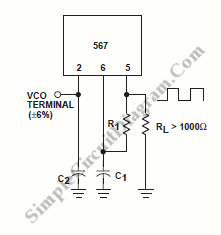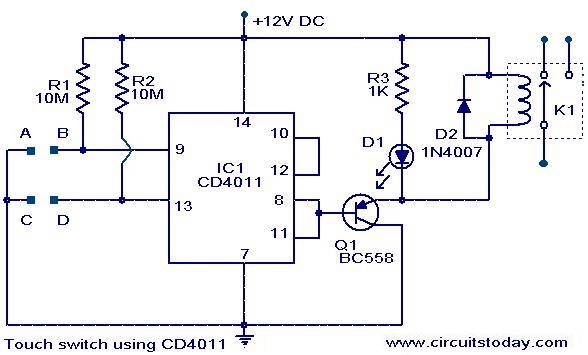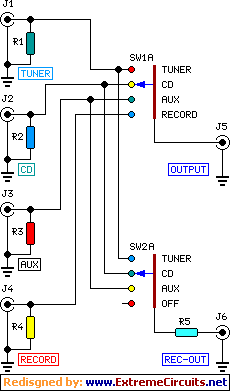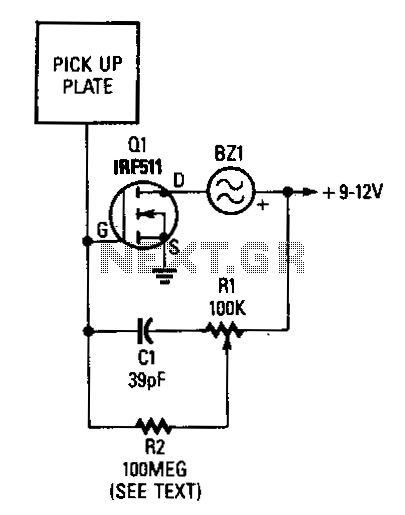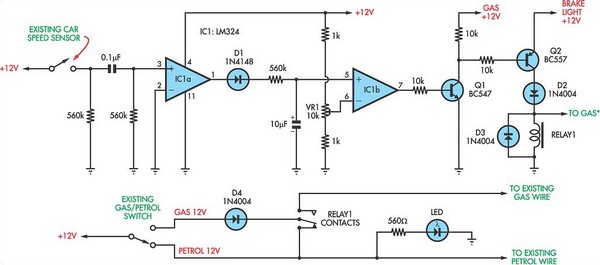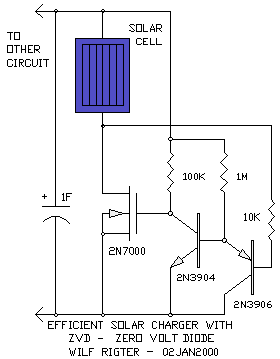
Master/Slave Switch
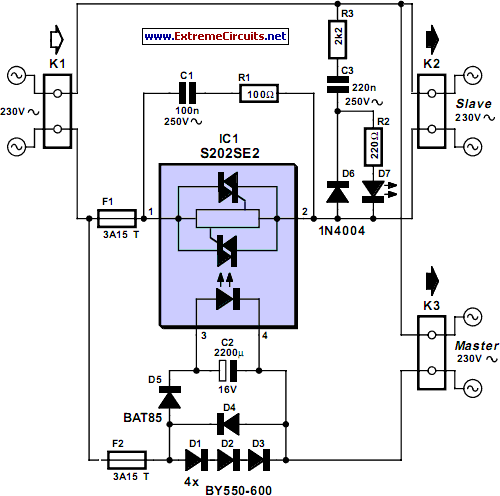
In this modern era, any relationship characterized as master/slave may raise ethical concerns; however, for this circuit, it effectively illustrates its operation. The circuit detects the mains current supplied to a master device and controls the on/off state of slave equipment. This functionality is particularly advantageous in typical hi-fi or home computer setups, where multiple peripheral devices can be managed simultaneously. A solid-state relay from Sharp serves as an optimal switching component in this scenario; it features an integrated zero-crossing detector that ensures switching occurs only when the mains voltage approaches zero, thereby minimizing interference. The triac drive circuitry, including optical coupling, is fully integrated on-chip, resulting in a design that requires very few external components and no additional power supply. This enhances the compactness of the final product. Diodes D1, D2, D3, and D4 are responsible for current sensing and generate a voltage on capacitor C2 when the master device is activated. A Schottky diode is utilized for D5 to minimize forward voltage losses. The circuit is highly sensitive and can effectively switch the slave device even when the master consumes minimal mains current. The RC network created by resistor R1 and capacitor C1 offers protection for the solid-state relay against voltage transients from the mains. As this circuit interfaces with mains power, it is crucial to recognize that the chip may carry lethal voltages on its pins, necessitating strict adherence to safety guidelines. Additionally, the LED should be installed behind a transparent plexiglass shield for safety.
This circuit operates as a master/slave controller, utilizing a solid-state relay to manage the power state of connected devices based on the current draw of a master device. The design incorporates a zero-crossing detection feature to enhance safety and reduce electromagnetic interference during switching events. The integration of the triac drive circuitry within the relay minimizes the need for external components, facilitating a more compact design that is easier to implement in various applications.
The current sensing function is achieved through diodes D1, D2, D3, and D4, which detect the current flowing to the master device. When the master device is powered on, these diodes generate a corresponding voltage across capacitor C2, which triggers the solid-state relay to activate the slave equipment. The use of a Schottky diode for D5 is particularly advantageous, as it ensures minimal voltage drop, thereby improving the circuit's efficiency and responsiveness.
The RC network formed by R1 and C1 serves a dual purpose: it not only protects the relay from voltage spikes that could occur due to fluctuations in the mains supply but also helps to filter out noise, ensuring stable operation. The overall design must take into account the high voltages present in the circuit, which necessitates careful layout considerations and the implementation of appropriate safety measures, such as the use of a plexiglass shield for the LED indicator.
In summary, this circuit exemplifies a practical solution for controlling multiple devices within a home or audio environment, leveraging modern solid-state technology to achieve reliable and efficient operation.In this age of enlightenment any sort of relationship that could be described as master/slave would be questionable but for the purposes of this circuit it gives a good idea of how it functions. The circuit senses mains current supplied to a master` device and switches slave` equipment on or off.
This feature is useful in a typical hi-fi or home c omputer environment where several peripheral devices can all be switched on or off together. A solid-state relay from Sharp is an ideal switching element in this application; a built-in zero crossing detector ensures that switching only occurs when the mains voltage passes through zero and any resultant interference is kept to an absolute minimum. All of the triac drive circuitry (including optical coupling) is integrated on-chip so there are very few external components and no additional power supply necessary.
This makes the finished design very compact. Diodes D1, D2, D3 and D4 perform the current sensing function and produce a voltage on C2 when the master equipment is switched on. A Schottky diode is used for D5 to reduce forward voltage losses to a minimum. The circuit is quite sensitive and will successfully switch the slave even when the master equipment draws very little mains current.
The RC network formed by R1 and C1 provides some protection for the solid-state relay against mains-borne voltage transients. This circuit is connected to the mains. it is important to be aware that the chip has lethal voltages on its pins and all appropriate safety guidelines must be adhered to!
This includes the LED, for safety it must be fitted behind a transparent plexiglass shield. 🔗 External reference
This circuit operates as a master/slave controller, utilizing a solid-state relay to manage the power state of connected devices based on the current draw of a master device. The design incorporates a zero-crossing detection feature to enhance safety and reduce electromagnetic interference during switching events. The integration of the triac drive circuitry within the relay minimizes the need for external components, facilitating a more compact design that is easier to implement in various applications.
The current sensing function is achieved through diodes D1, D2, D3, and D4, which detect the current flowing to the master device. When the master device is powered on, these diodes generate a corresponding voltage across capacitor C2, which triggers the solid-state relay to activate the slave equipment. The use of a Schottky diode for D5 is particularly advantageous, as it ensures minimal voltage drop, thereby improving the circuit's efficiency and responsiveness.
The RC network formed by R1 and C1 serves a dual purpose: it not only protects the relay from voltage spikes that could occur due to fluctuations in the mains supply but also helps to filter out noise, ensuring stable operation. The overall design must take into account the high voltages present in the circuit, which necessitates careful layout considerations and the implementation of appropriate safety measures, such as the use of a plexiglass shield for the LED indicator.
In summary, this circuit exemplifies a practical solution for controlling multiple devices within a home or audio environment, leveraging modern solid-state technology to achieve reliable and efficient operation.In this age of enlightenment any sort of relationship that could be described as master/slave would be questionable but for the purposes of this circuit it gives a good idea of how it functions. The circuit senses mains current supplied to a master` device and switches slave` equipment on or off.
This feature is useful in a typical hi-fi or home c omputer environment where several peripheral devices can all be switched on or off together. A solid-state relay from Sharp is an ideal switching element in this application; a built-in zero crossing detector ensures that switching only occurs when the mains voltage passes through zero and any resultant interference is kept to an absolute minimum. All of the triac drive circuitry (including optical coupling) is integrated on-chip so there are very few external components and no additional power supply necessary.
This makes the finished design very compact. Diodes D1, D2, D3 and D4 perform the current sensing function and produce a voltage on C2 when the master equipment is switched on. A Schottky diode is used for D5 to reduce forward voltage losses to a minimum. The circuit is quite sensitive and will successfully switch the slave even when the master equipment draws very little mains current.
The RC network formed by R1 and C1 provides some protection for the solid-state relay against mains-borne voltage transients. This circuit is connected to the mains. it is important to be aware that the chip has lethal voltages on its pins and all appropriate safety guidelines must be adhered to!
This includes the LED, for safety it must be fitted behind a transparent plexiglass shield. 🔗 External reference
